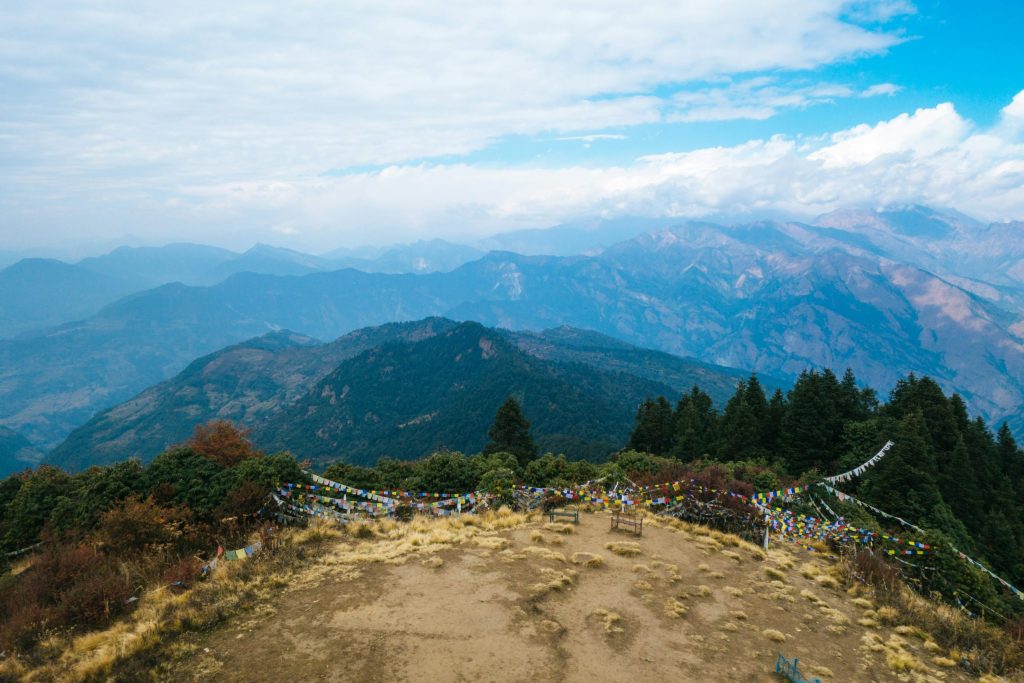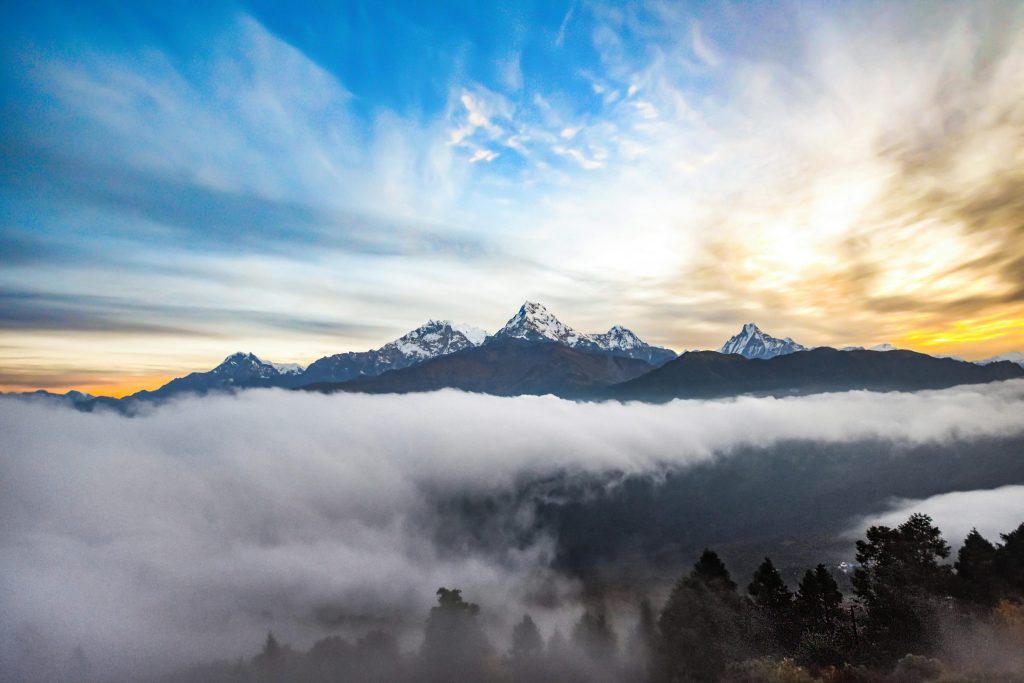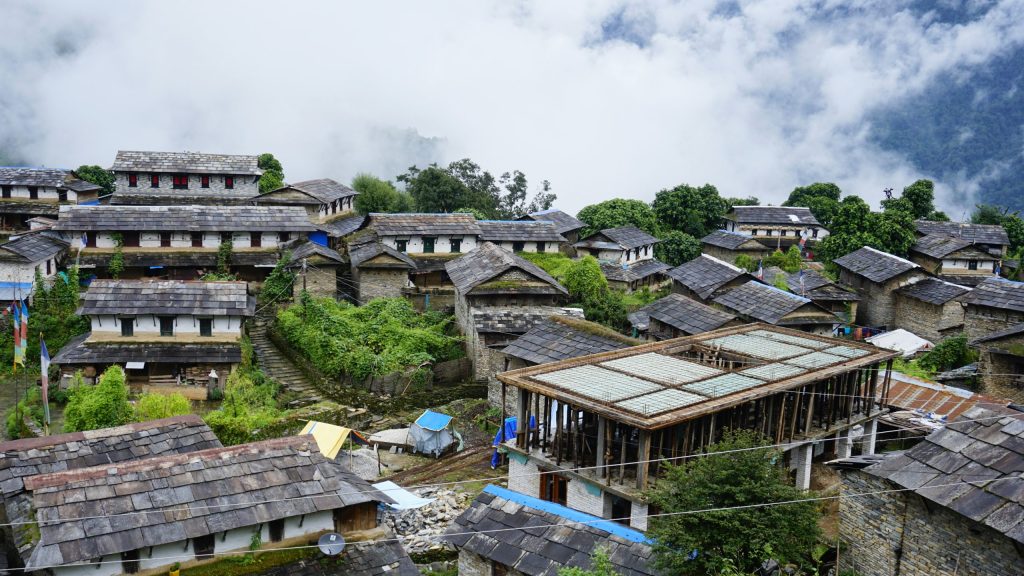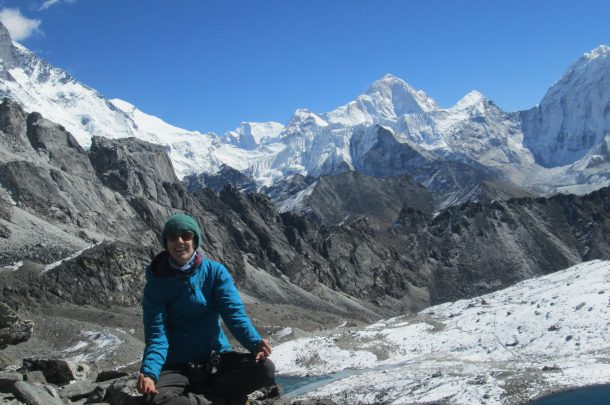The Ghorepani Poon Hill Trek is a delightful short trip that takes you to the gorgeous Annapurna region of Nepal. It is a breathtaking journey that presents to you sweeping views of the Annapurna Himalayas paired with a natural landscape embedded with a wide myriad of endangered species of animals.
This trip combines the best parts of the Annapurna region, letting you enjoy its culture, nature, and stunning Himalayan views without a long and difficult trek to high altitudes. It’s perfect for those who want a short adventure that still takes them close to the Himalayas.

The most iconic part of the Ghorepani Poon Hill Trek is witnessing the stunning sunrise over the Annapurna and Dhaulagiri ranges. Trekkers start early in the morning to reach the viewpoint, where the first golden rays touch the snow-covered peaks. The 360-degree Himalayan panorama, featuring Annapurna South, Machhapuchhre, and Hiunchuli, offers a truly unforgettable experience for photographers and nature lovers.

This trek is filled with breathtaking mountain views from start to finish. The trail showcases a mix of terraced farmlands, lush green hills, and distant white peaks, including the Annapurna and Dhaulagiri massifs. These ever-changing landscapes make the Ghorepani Poon Hill Trek one of the most picturesque short treks in Nepal.

Along the route, you will explore traditional villages such as Ghorepani and Ghandruk, inhabited by the Gurung and Magar communities. These settlements are known for their warm hospitality, traditional stone houses, and vibrant culture. Meeting the locals and learning about their way of life adds a rich cultural experience to the natural beauty of the trek.

During spring, the trekking paths come alive with blooming rhododendron flowers, creating a colorful and enchanting atmosphere. Walking through these lush forests offers a refreshing connection with nature and a peaceful trekking experience. The area is also home to various bird species, making it a delight for nature enthusiasts.
The Poon Hill Trek begins with a scenic drive to Pokhara, one of Nepal’s most popular travel destinations. As you travel through the winding roads of Kathmandu’s countryside, the sight of the Annapurna peaks welcomes you to this beautiful lakeside city. Located beside the sparkling Phewa Lake, Pokhara offers not only stunning Himalayan views but also exciting adventure activities and famous attractions.
From Pokhara, the journey continues on a well-marked trail through traditional Gurung and Magar villages. The path follows the Modi River, winding up and down ridges and valleys, offering cultural encounters at every turn. Along the way, trekkers are rewarded with breathtaking views of the Annapurna and Dhaulagiri ranges, as well as Mt. Machhapuchhre (6,997m) and Hiunchuli (6,441m).
A key highlight of the trek is the early morning hike to Poon Hill, a famous viewpoint for its sweeping panorama of the Annapurna massif. Watching the sunrise here is a magical experience as the first light paints the snow-capped peaks in shades of gold and orange—a truly unforgettable moment.
Also known as the Annapurna Sunrise Trek or Annapurna Panorama Trek, the Ghorepani Poon Hill route is one of Nepal’s most classic and accessible treks. While it is considered an easy to moderate trek, it includes the challenging ascent of Ulleri, where you’ll climb over 3,300 stone steps—a rewarding test of stamina before the stunning views ahead.
Duration: The Ghorepani Poon Hill Trek typically takes around 9 days to complete. However, there are shorter itinerary options available for those with limited time:
Physical Fitness: A moderate level of fitness is required, making it a great choice for both beginners and first-time trekkers.
Health Condition: Trekkers should be in good health and physically fit to enjoy the journey.
Age Requirements: There are no strict age limits, so it’s suitable for all age groups.
Daily Walking Hours: Be prepared to walk 5–6 hours each day, including some steep stone steps and forest trails.
Passport: Foreign travelers must carry a valid passport with at least six months’ validity.
Health and Travel Insurance: Strongly recommended for safety, covering trekking-related activities.
The Ghorepani Poon Hill Trek is possible year-round, but the ideal time to visit for clear mountain views and pleasant weather is during spring (March to May) and autumn (September to November). These seasons offer bright, clear skies and comfortable temperatures, perfect for trekking in the Annapurna region.
Spring brings vibrant rhododendron flowers that line the trail, creating a colorful and scenic trek. Autumn, following the monsoon, provides stable weather and fresh air, making it the most popular season for the Ghorepani Poon Hill Trek.
Winter months can be very cold with occasional snowfall, while the monsoon season (June to August) brings heavy rains, slippery trails, and limited visibility. For the best experience with amazing panoramic views and ideal trekking conditions, plan your Ghorepani Poon Hill Trek during spring or autumn seasons.
Before starting the Ghorepani Poon Hill Trek, trekkers must obtain two important permits to legally enter the Annapurna region.
The first is the Annapurna Conservation Area Permit (ACAP), which supports the protection of the natural environment and wildlife in the area. This permit is compulsory for everyone trekking within the Annapurna Conservation Area.
The second permit is the Trekkers’ Information Management System (TIMS) Card, issued by the Nepal Tourism Board. This card helps ensure the safety of trekkers and is mandatory for trekking in popular regions like Ghorepani and Poon Hill.
Note: Highroute Adventure will arrange both ACAP and TIMS permits for you before you begins your trek. Always carry your permits with you, as park authorities regularly check them during the trek.
If you want to make your trek more exciting, you can add the Annapurna Base Camp trek to your trip. Check out the 13-day Annapurna Base Camp Trek with Ghorepani package.You may arrive in Kathmandu at any time. Upon your arrival, you will be greeted by one of our airport representatives who will help you get transferred to your Hotel. There are no planned activities for the day, thus you may check into your Hotel and relax. In the evening you will meet your trekking member and ask questions if you have any. so you have to check your final list of gear and other important things. If you feel like it, visiting around the tourist hub of Thamel. if your schedule arrival in Kathmandu early in the morning or afternoon time, you have enough time to attend the pre-trekking briefing time and exploring time. Overnight stay at the Hotel in Kathmandu.
Today, you will be driving to Pokhara. It is the second-largest city of Nepal and also its commercially famous tourist hub. Pokhara is situated beside the Phewa Lake and near the Annapurna Mountains. After a drive through the countryside past roadside villages and terrace farms, you will reach Pokhara. In the evening, you can also enjoy a leisurely boat ride in the lake. Overnight stay at the Hotel in Pokhara.
From Pokhara, you will have an hour's drive to Nayapul, winding through the Pokhara valley on the Baglung Highway. Nayapul is situated amidst hillocks and cliffs and along the way, you can get good views of the Machhapuchhre Peak and the Annapurna Himal. The dirt-laden trekking trail from Nayapul extends towards the Modi-River and settles Birethanti. Further from here lays Tikhedhunga. Overnight stay at the teahouse at Tikhedhunga.
The trail is a steep 2-hour trudge towards the village of Ulleri from Tikhedhunga. Branching further on from Ulleri, the path crosses streams and thick woodlands of rhododendron to reach the Magar village of Banthanti. Views of the Machhapuchhre (6997m), Hiunchuli (6441m), and Annapurna South (7219m) from Banthanti are spectacular. The view is like watching a painting come to life. The path then winds onward to Nangethanti. A few miles further lays Ghorepani from where soaring views of the Dhaulagiri Peak decorate the skyline. Overnight stay at the guesthouse at Ghorepani.
Early in the morning, you will hike to the vantage point of Poon Hill that presents panoramic views of the entire Annapurna and Dhaulagiri massif and many of its neighboring peaks along with Mt. Machhapuchhre (6997m). The sunrise view from Poon Hill is an out-of-this-world experience. After spending time at Poon Hill, you will return to Ghorepani, have breakfast and then trek towards Tadapani, walking past pine and cedar woods and thick bamboo groves. Overnight stay at the guesthouse at Tadapani.
Three hours trekking through the forests of ancient oak trees, you will reach Ghandruk- a large Gurung village that presents striking views of the Annapurna peaks. It is an easy trek that is quite pleasant and filled with a magical ambiance. Here, you can explore the village and relish the uniqueness of the Gurung culture and traditions. You can also indulge in traditional Gurung songs and dances in the evening. Overnight stay at the guesthouse at Ghandruk.
From Ghandruk, you will trek down the valley floor towards Nayapul, from where you will then have a drive back to Pokhara. It is a beautiful journey, both the trek as well as the drive back. Upon reaching Pokhara, you will be dropped off at your Hotel. Overnight stay at the Hotel in Pokhara.
Today, you will bid goodbye to the Annapurna Himalayas and drive back to Kathmandu, following the same highway as before. In Kathmandu, you can feel free to explore the city and shop for gifts and souvenirs. Overnight stay at the Hotel in Kathmandu.
Approximately three hours before your scheduled flight, you will be dropped off at the airport for your departure.
High Route Adventure will arrange three meals a day for you during the Ghorepani Poon Hill trek. You can enjoy breakfast, lunch, and dinner at the teahouses along the trail, ensuring you stay energized throughout your journey.
The meals typically include a variety of local and few international dishes(made in Nepali style), such as dal bhat (rice and lentils), noodles, soups, and fresh vegetables. Our team ensures that you have nutritious and delicious food options to keep you strong and comfortable during the trek.
Whether you prefer vegetarian or non-vegetarian meals, High Route Adventure will accommodate your dietary needs. We work with local teahouses to provide clean, healthy, and satisfying meals so you can focus on enjoying the beautiful trekking experience.
High Route Adventure will book accommodation for you in simple and cozy teahouses along the Ghorepani Poon Hill Trek. These teahouses provide basic yet comfortable rooms where you can relax after a day of trekking.
Most rooms are shared with other travelers, creating a warm and friendly atmosphere on the trail. Sharing rooms is common and helps keep your trip affordable.
Facilities like hot showers, WiFi, and electricity are available at many teahouses but usually come with an extra cost. You can also request a simple room with an attached bathroom for an additional fee. It’s a good idea to carry some extra cash if you want to use these extra services during your trek.
The Ghorepani Poon Hill Trek is considered a moderate trek, but it does come with some challenges. One of the main difficulties is the steep climb, especially the long stone staircase at Ulleri, where you may need to climb over 3,300 steps. This requires good stamina and leg strength and it can be tough especillay for the first time trekkers.
Altitude can also be a challenge, as the trek reaches elevations above 3,000 meters. Some trekkers might experience mild altitude sickness, so proper acclimatization and hydration are important.
Weather conditions vary throughout the year, and during the monsoon season, slippery trails and rain can make trekking harder. Cold temperatures during winter mornings and nights can also be tough for some.
Despite these challenges, the Ghorepani Poon Hill Trek remains accessible for most people with moderate fitness, and the stunning views make the effort worthwhile. Proper preparation and pacing can help you enjoy a safe and rewarding trekking experience.
Preparing well for the Ghorepani Poon Hill Trek will make your journey safer and more enjoyable. Start by building your fitness with regular walking, jogging, or hiking at least 4–6 weeks before your trek. Focus on endurance and leg strength to handle steep climbs like the Ulleri staircase.
Pack appropriate clothing for varying weather—layered clothes for cold mornings and warmer days, waterproof gear for the rainy season, and sturdy trekking boots for rough trails. Don’t forget essentials like a hat, sunglasses, and sunscreen to protect yourself from sun exposure at higher altitudes.
Acclimatization is important to avoid altitude sickness, so take your time and stay hydrated during the trek. Learn basic first aid and carry a small medical kit. Booking your trek with a reliable company like High Route Adventure ensures support with permits, guides, accommodation, and emergency plans, helping you prepare smoothly for the adventure ahead.
There are several options to travel from Kathmandu to Pokhara. Regular tourist buses depart from Gongabu Bus Station, offering an affordable way to reach Pokhara. You can also choose a comfortable Hiace van for a faster road trip.
If you prefer to save time, flying is the quickest option. The flight takes about 25 minutes, but you will need to pay for your ticket separately. High Route Adventure can help arrange your flight booking upon request.
Traveling by road usually takes between 6 to 8 hours, depending on traffic and road conditions. Whether you choose bus, van, or flight, each option offers a unique experience on the way to Pokhara.
Yes, it is possible to trek solo on the Ghorepani Poon Hill Trek. However, due to new regulations, it is mandatory to hire a trekking guide for your safety and support during the journey. Having a guide not only ensures your security but also enhances your experience with local knowledge and assistance throughout the trek.
At High Route Adventure, we provide licensed trekking guides who speak fluent English to ensure clear communication and a better trekking experience. For every two trekkers, we assign one porter to help carry your luggage and make the trek easier. Our porter carry weight of 20kg so make sure your laugage for each person is not more than 10kg.
If you are traveling in a large group, we also arrange assistant trekking guides to offer extra support and ensure everyone’s safety and comfort throughout the journey.
After completing the Ghorepani Poon Hill Trek, if you want to spend more time relaxing and exploring, Pokhara has plenty to offer. Some highly recommended places to visit include Sarangkot for stunning sunrise and mountain views, Davis Falls for a beautiful waterfall experience, and the peaceful Phewa Lake where you can enjoy boating.
Other popular spots are the World Peace Pagoda, Gupteshwor Cave, and the lively Lakeside area filled with shops and cafes. Spending extra days in Pokhara is a great way to unwind and enjoy the natural beauty after your trek.

The Ghorepani Poon Hill Trek map outlines a scenic circular route in the lower Annapurna region of Nepal. The trek usually starts from Nayapul or Ulleri, passing through charming villages like Ghorepani, Tadapani, and Ghandruk before looping back to Pokhara.
Key highlights on the map include:
The trail on the map is well-marked, making it easy for independent trekkers and guided groups alike. The trek takes 4–6 days depending on the route and pace.
Everything You Need for a Comfortable and Scenic Trek in the Annapurnas
The Ghorepani Poon Hill Trek is a short and moderate trek in Nepal, perfect for beginners and families. It doesn’t go to extreme altitudes, but the weather can change quickly, and the trail includes forest paths, stone steps, and ridge walks. Packing smart helps you stay comfortable and enjoy the journey without carrying unnecessary weight.
Nepal’s mountain weather can be sunny, cold, windy, or rainy — all in one day. So dressing in layers is the key.
Most teahouses provide blankets, but it’s best to carry your own bag for warmth and comfort.





